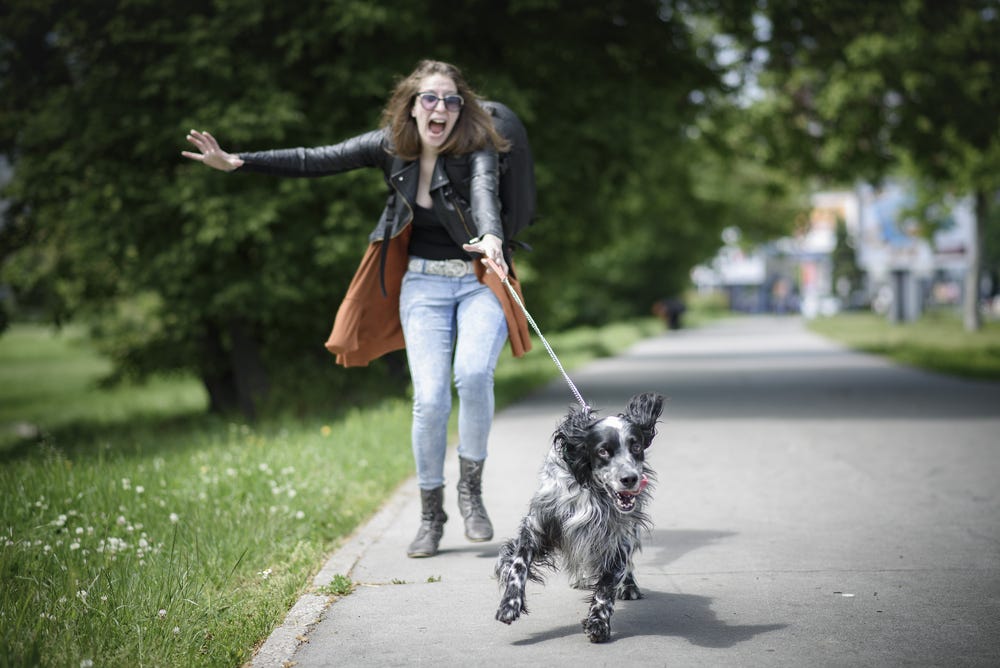Leash Aggression in Dogs: Causes, Signs, and Management Strategies
Does your dog become deranged when it sees another dog approaching? Learn how to recognize and correct leash aggression in dogs.

I am lucky enough to have a super social, uber friendly, and very submissive, female labrador who is hardly ever on a leash, but this means that we frequently experience leash aggression from other dogs when she gets too close to them. When other dogs display any sort of hostility my dog knows to ignore them, she looks at me, I shake my head and then she just blanks them completely.
My dog isnt a problem on leash other, but I can't say the same about my friends female labrador. Nala is very social with other dogs when off leash, but when she is on it she turns into some sort of demon hound towards any dog she doesn't know. When she sees us approach she never barks because she knows us, but god help you if you don't know her and happen to be walking your dog close by. She will assume you and your dog are both terrorists and aggressively bark at you.
Very embarrassing for the owners, I kind of feel sorry for them. While I can go pretty much anywhere with my dog, they can't really take theirs anywhere, not if there are other dogs around, their dog causes too much of a problem, and nobody will tolerate aggressive behaviour from a dog for long, no matter what its size.
The Causes Of Leash Aggression
I think a large part of the problem are dog owners who have never properly socialized their dogs, and who believe that their dogs leash aggression isn't a problem if other dogs stay away. These people are abusive owners, and there are far too many of them who do not like their dogs socializing with other dogs.
If you tried to raise a child in isolation from other children, we would call you a child abuser, and your child would more than likely be taken away from you by social services. But some owners seem to think it's fine to raise a dog in this way, then act surprised when their dog develops severe behavioural issues later on.
Research indicates that socialization leads to happier, and less aggressive dogs, it also tells us that well socialized dogs have longer life spans than those who have not been properly socialized. These owners are literally shortening their own dogs lifespan by failing to let them socialize with other dogs properly.
Socialization is a critical phase in a dog's life, particularly during the puppy stages between 3 to 14 weeks. During this time, puppies are especially receptive to socializing with other dogs, but a lack of socialization during this crucial period can result in a dog being fearful or aggressive towards other dogs in adulthood. If your dog hasn’t had positive experiences with other dogs or has had limited exposure to them, they will definitely become fearful or defensive when encountering them later, especially in the constrained context of being on a leash.
Unsocialized dogs can become anxious or scared because they haven't had a chance to learn play and communication cues from other dogs, they completely misinterpret the other dogs intentions and get overwhelmed when meeting them. When a leash restricts their ability to escape from another dog, the flight option is taken off the table when their fight or flight mode kicks in for them, leaving fight as the only option. They also could be jealous and trying to protect their owners from a strange dog, becoming territorial in order to 'protect' them.
Of course even the most well socialized dogs can be leash aggressive, like my friends dog Nala who becomes leash aggressive out of sheer frustration, dogs are innately social creatures, especially Nala, and if you restrict her to a leash for long enough, she will become frustrated at being on it with other dogs around. She could also be remembering a past trauma haunting her memory, which causes her to react aggressively in similar situations. If a dog has been attacked by a dog in the past or more than once, they learn to expect to be attacked by other dogs in the future, and react aggressively when they see other dogs.
My guess though is that she might just have what the Spanish call 'mala leche'.
If you want to avoid leash aggression, and raise a well balanced and mentally resilient dog, properly socialize them with other dogs when they are puppies, and continue to socialize them throughout the rest of their adult lives.
What Does Leash Aggression Look Like?
You know it when you see it, the vocal signs are hard to ignore, incessant barking or yapping, growling or whining indicating discomfort or fear. You see physical signs on the dogs themselves, their hackles become raised, their teeth are bared, and they lunge at the target of their aggression. We have all come across dogs like this before on our walks, I like to silently look their owners in the eye and shake my head at them in disappointment in my own display of passive aggressiveness.
Usually the owners half heartedly tell them to stop, perhaps issue a little apology, but do little else to correct their dogs behaviour short of pulling on the leash or shouting at them. They have been through this act with other dog owners many times before, and are well practiced at apologizing for their deranged dogs.
I personally do not care why your dog is aggressive, and think it as your responsibility to correct as the owner. But how can you correct this behaviour?
Techniques For Managing Leash Aggressiveness
Alleviating leash aggression isn't an overnight job, it requires a strategic blend of patience, understanding, and consistent training to train a leash aggressive dog to be calm in the presence of other dogs. It also requires you to be consistent in your approach with this training, learn about the problem, and learn training techniques to counter it. This is called being a responsible dog owner.
Desensitization and Counter Conditioning: While the name of this method of alleviating leash aggression may sound like a cruel and unusual punishment, it's actually a harmless technique to gradually acclimatize a dog to its trigger. By exposing the dog to a less intense version of the stimulus that triggers it, and coupling it with positive reinforcement, a dog’s emotional response can be altered over time. For instance, if a dog reacts at a ten-foot distance from another canine, training can begin at fifteen feet, rewarding calm behavior and gradually narrowing the distance. Here is a good article by the American Kennel Club with more on this technique, it has proven to be an effective one.
A Harness Rather Than A Collar: Swapping your dog collar for a harness will enable you to better control a dog that is being physically aggressive, and enabling greater corrective control in a way that doesn't inflict pain. Avoid choke chains or prong collars, as they can often worsen the aggression by causing the dog to suffer physical pain when its triggered by another dog.
Basic Command Training: Going back to puppy training basics and reinforcing your dogs training on foundational commands helps create a distraction framework that you can use during moments of potential aggression. A dog engrossed in obeying a "sit" or "stay" command is less likely to focus on external triggers, especially if there is a treat involved. If you see another dog approaching, take out a treat and distract your dog with basic training exercises.
Seek Expertise: A responsible dog owner will take steps to correct leash aggression in their dog, but if your dogs aggression is too challenging for you to manage you there is no shame in consulting a professional dog trainer or behaviorist. They bring a wealth of experience and can offer tailored strategies for dealing with your dogs aggression after seeing them. Whatever you do, don't just read this article, listen to me, and then try to fix your dog. If you can't drill down further into this subject, gain a proper understanding of it, diagnose the cause of your dog's leash aggression, and deal with it yourself then seek expert help.
Promote Socialization: Expose your dog to different social situations on a regular basis, can significantly reduce fear and uncertainty in dogs. Over time, they learn that not every unfamiliar experience is a threat, they learn to be with other dogs, and behave themselves. I socially baptise my puppies by throwing them into large groups of off leash dogs at an early age, they almost always get marked by a older dog at some point when they are new to the pack, and they squeal to high heaven and might not want to go back to the dog park afterwards.
I can quite understand a new dog owner freaking out at their dog being 'bitten' by an older dog and not wanting to take it to the dog park to socialize because of it, but all newcomers to the pack get lightly bitten at some point.
To be marked (lightly bitten) by another dog is practically a rite of passage in a young dogs life, they always get over it, and quickly learn to run with the pack without fear if you let them. In our group if we see a dog marking the young ones we will strongly correct them for it, but many groups allow it because it is something that occurs naturally as dogs find their place in the pecking order.
Puppies always find their feet and learn to love being with their pack.
While lack of socialization can be a contributing factor to leash aggression, it's just one piece of the puzzle. Each dog is an individual with its own set of experiences and temperament, but I cannot overstress the benefits of early and regular socialization. If your dog has missed their early socialization, recognizing the leash aggression problem and correcting it can help your dog to become a much happier, and more balanced canine companion. Good luck!
** I am not a dog behavioral expert, if you have some good advice to offer that I may have missed, or wish to correct me, let me know in the comments!


